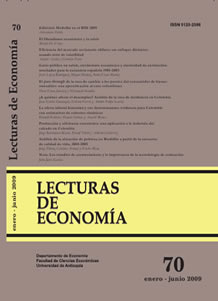Producción y eficiencia estocástica: una aplicación a la industria del calzado en Colombia
DOI:
https://doi.org/10.17533/udea.le.n70a2259Abstract
Este artículo caracteriza y estudia la eficiencia de un conjunto representativo de firmas en el sector de calzado y marroquinería de cuero en Bogotá, Bucaramanga, Cúcuta y el Área Metropolitana de Medellín. El análisis se basa en una encuesta sobre múltiples factores de la producción en esta industria (insumos, integración de actividades, gestión administrativa, innovación, exportaciones, etc.). Nuestros resultados indican que una parte razonable de la varianza total es explicada por la varianza asociada al término de ineficiencia. adicionalmente, en esta muestra existen rendimientos marginales decrecientes en el uso del factor trabajo y, aunque muchas de las empresas son relativamente eficientes, el sector está aún lejos de funcionar en la frontera de posibilidades de producción.
Palabras clave: Eficiencia, frontera estocástica, calzado y cuero. Clasificación JEL: C13, C20,D24
Abstract:
In this paper, we characterize and study the efficiency of a representative set of firms in the leather and footwear sector in Bogotá, Bucaramanga, Cúcuta and the Metropolitan Area of Medellin. This study is based on a survey addressing multiple aspects of production in this industry (inputs, integration of activities, administrative management, innovation, exports, etc). Our results suggest that a reasonable percentage of total variance is accounted for by the variance of the inefficiency term. Additionally, the sample exhibits diminishing returns to labor. Even though many firms seem to be efficient, the leather sector as a whole is not operating near its production possibilities frontier.
Keywords: Efficiency, stochastic frontier, footwear and leather products. JEL Classification: C13, C20, D24
Résumé:
Cet article étudie l'efficience d'un ensemble représentatif d'entreprises associées au secteur de la chaussure et de la maroquinerie établies dans les villes de Bogotà, Bucaramanga, Cúcuta et la Zone Métropolitaine de la ville de Medellín. L'analyse est construite sur une enquête concernant un ensemble de facteurs associés à la production du secteur (moyens de production, intégration des activités, gestion, innovation, exportations, etc.). Nos montrons qu'une partie importante de la variance totale est expliquée par la variance relative à l'inefficacité. Nous montrons également que, même s'il existe des rendements marginaux décroissants dans l'utilisation du facteur travail et même si les entreprises sont relativement efficaces, le secteur de la chaussure est encore loin de se positionner sur la frontière de possibilités de production.
Mots clé: Efficience, frontière stochastique, chaussures et cuir. Classification JEL : C13, C20, D24
Downloads
Published
How to Cite
Issue
Section
License
This page, by Universidad de Antioquia, is licensed under a Creative Commons Attribution License.
Authors who publish with this journal agree to retain copyright and grant the journal right of first publication, with the article licensed under a Creative Commons Attribution-NonCommercial-ShareAlike License allowing others to share it as long as they acknowledge its authorship and original publication in this journal.
Authors can enter into separate, additional contractual arrangements for the non-exclusive distribution of the journal's published version of the work (e.g., post it to an institutional repository or publish it in a book), provided that these arrangements be not for profit and the journal be acknowledged as the original source of publication.
Authors are permitted and encouraged to post their papers online (e.g., in institutional repositories or on their websites), as it can lead to valuable exchanges as well as greater citation of the published work.















